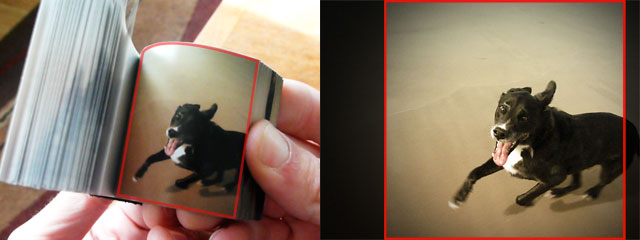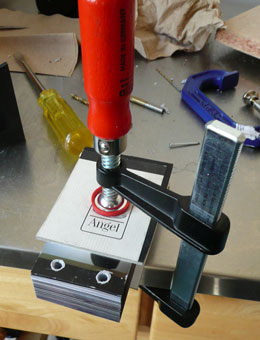FYI: The following process is based on my experiments in creating flipbooks back in 2008, before HD video was commonly in use in consumer cameras.

I can’t quite remember how I got the idea, but I thought it would be fun to create some flipbooks based off of video I had shot. The challenge was to be able to efficiently process the frames from a 3-5 second clip, have them printed by a photography shop, and assemble them as easily as possible.
As a heavy After Effects user, I wanted to create a project template (flipbook_template.zip) that would input video from my camera and quickly export out a sequence of frames for print. I didn’t have a decent office printer at the time, plus I like the quality of a professionally developed print, so my output would need to be in a format that a photography shop could handle. I usually send my digi-pics to Ritz Photo, but any photo shop will work.
A 4×6 print is the cheapest format I could choose, so that became my output size. However, I felt a full 4×6 flipbook would be a little too big and clunky – plus pricey when you’re getting 100 or so prints made per book. I played around in Photoshop and created a template that fit 4 frames of 640×480 video (from my Panasonic Lumix digicam) per sheet. Unless I had an HD camera, the scaled down frame also made for a better quality shot.
With the crop marks created in Photoshop, I produced a template within After Effects that takes a video as input, and through some expressions I wrote, seperates and numbers each frame to a specific quadrant on the 4×6 print, and then outputs a sequence of JPGs. The following is a sample of one such print:
As a heavy After Effects user, I wanted to create a project template (flipbook_template.zip) that would input video from my camera and quickly export out a sequence of frames for print. I didn’t have a decent office printer at the time, plus I like the quality of a professionally developed print, so my output would need to be in a format that a photography shop could handle. I usually send my digi-pics to Ritz Photo, but any photo shop will work.
A 4×6 print is the cheapest format I could choose, so that became my output size. However, I felt a full 4×6 flipbook would be a little too big and clunky – plus pricey when you’re getting 100 or so prints made per book. I played around in Photoshop and created a template that fit 4 frames of 640×480 video (from my Panasonic Lumix digicam) per sheet. Unless I had an HD camera, the scaled down frame also made for a better quality shot.
With the crop marks created in Photoshop, I produced a template within After Effects that takes a video as input, and through some expressions I wrote, seperates and numbers each frame to a specific quadrant on the 4×6 print, and then outputs a sequence of JPGs. The following is a sample of one such print:

One thing to keep in mind when setting up your video in After Effects are the parts of the frame that will be hidden by the spine. As you can see below, the viewable area for the final flipbook is smaller than the full video frame. So if there is important action on the left side of the frame, it might be obscured by the spine and the fact you’re never really opening up the book – just flipping through it quickly. I added a layer in the project which estimates the viewable area, as seen in the lower right photo.

In the AE project, I have setup two output comps, one for a 15fps export and a 30fps export. Both export about 25 high-quality 4×6 prints, meaning the final flipbook will be about 100 pages long – a good size without feeling too thick. This means the 15fps comp will export a 6.6 second long book while the 30fps comp will get you a little over 3 seconds. Of course you can edit the comp as you please and make it longer or shorter, creating a thicker or thinner book.
I chose a matte finish for the prints – I felt the glossy finish would pick up too many finger prints, as this is an interactive object. Of course, if you print your own at home, there are a slew of other options, such and double sided printing, so you could potentially have two flipbooks in one.
Once the prints are made, the next step is to cut out the four frames from each print, a bit of a time-consuming process involving an exacto knife and ruler. I’m sure there are better ways to cut up the book, and any ideas are appreciated. If you have access to a paper guillotine, it might speed things up a lot.
Once you have your stack, the final step is to bind the book. Clamping the pages together, I drove two holes with an electric hand drill, which turns out not to be as easy as I thought – it takes a lot of finesse (and a file) to make a clean cut. One reader wrote in a suggestion to use a specialty paper drill, which has a hollow tube and sharp edge to make a clean hole. If you have access to one of those, that would be highly recommended.
I chose a matte finish for the prints – I felt the glossy finish would pick up too many finger prints, as this is an interactive object. Of course, if you print your own at home, there are a slew of other options, such and double sided printing, so you could potentially have two flipbooks in one.
Once the prints are made, the next step is to cut out the four frames from each print, a bit of a time-consuming process involving an exacto knife and ruler. I’m sure there are better ways to cut up the book, and any ideas are appreciated. If you have access to a paper guillotine, it might speed things up a lot.
Once you have your stack, the final step is to bind the book. Clamping the pages together, I drove two holes with an electric hand drill, which turns out not to be as easy as I thought – it takes a lot of finesse (and a file) to make a clean cut. One reader wrote in a suggestion to use a specialty paper drill, which has a hollow tube and sharp edge to make a clean hole. If you have access to one of those, that would be highly recommended.

I found some discarded leather at a second-hand shop that worked well as a wrap around the spine, and ordered some 1″ length brass Chicago screws (also called screw posts) online. Steel, or another hard metal will also work – I would just stay away from the aluminum kind, as they strip easily when tightening. If you make your book longer or shorter, you’ll need to make sure you have the proper length screws – a tight fit is necessary.
After making a few, I would probably consider adding to the template a version that uses two frames per print, so the final book is more horizontal. You would have to double the amount of prints to be made, but this would be the way to go for HD or widescreen footage, or in SD footage where you need to see the entire frame.
Once again, here’s the AfterEffects project file (CS3+) if you want to try creating your own: flipbook_template.zip
After making a few, I would probably consider adding to the template a version that uses two frames per print, so the final book is more horizontal. You would have to double the amount of prints to be made, but this would be the way to go for HD or widescreen footage, or in SD footage where you need to see the entire frame.
Once again, here’s the AfterEffects project file (CS3+) if you want to try creating your own: flipbook_template.zip